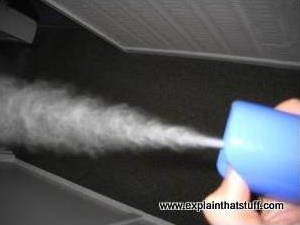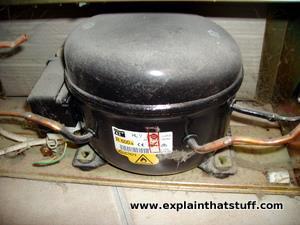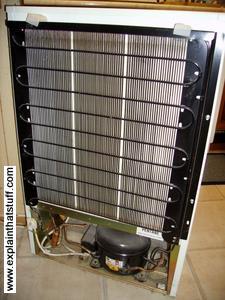Refrigerators
Now here's a cool idea: a metal box that helps your food last longer! Have you ever stopped to think how a refrigerator keeps cool, calm, and collected even in the blistering heat of summer? Food goes bad because bacteria breed inside it. But bacteria grow less quickly at lower temperatures, so the cooler you can keep food, the longer it will last. A refrigerator is a machine that keeps food cool with some very clever science. All the time your refrigerator is humming away, liquids are turning into gases, water is turning into ice, and your food is staying deliciously fresh. Let's take a closer look at how a refrigerator works!
How to move something you can't even see
Suppose your chore for today is to empty a stable full of rank smelling horse manure. Not the nicest of jobs, so you'll want to do it as quickly as possible. You won't be able to move it all at once, because there's too much of it. To get the job done fast, you need to move as much manure as you can in one go. The best thing to do is use a wheelbarrow. Pile the manure up into the barrow, wheel the barrow outside, and then empty the manure into a pile in the stable yard. With a few of these trips, you can shift the manure from inside the stable to outside.
Moving something you can see is easy. But now let's give you a harder chore. Your new task is to move the heat from the inside of a refrigerator to the outside to keep your food fresh. How can you move something you can't see? You can't use a wheelbarrow this time. Not only that, but you can't open the door to get at the heat inside, or you'll let the heat straight back in again. Your mission is to remove the heat, continually, without opening the door even once. Tricky problem, eh? But it's not impossible—at least not if you understand the science of gases.
How to move heat with a gas
Let's step sideways a moment and look at how gases behave. If you've ever pumped up the tires on a bicycle, you'll know that a bicycle pump soon gets quite warm. The reason is that gases heat up when you compress (squeeze) them. To make the tire support the weight of the bicycle and your body, you have to squeeze air into it at a high pressure. Pumping makes the air (and the pump it passes through) a little bit hotter. Why? As you squeeze the air, you have to work quite hard with the pump. Theenergy you use in pumping is converted into potential energy in the compressed gas: the gas in the tire is at a higher pressure and higher temperature than the cool air around you. If you squeeze a gas into half the volume, the heat energy its molecules contain fills only half as much space, so the temperature of the gas rises (it gets hotter).

What happens if you release a gas that's stored at high pressure? When you spray an aerosol air freshener, you've probably noticed that the spray is really cold—for exactly the opposite reason that a bicycle pump gets hot. When you release the gas, it is suddenly able to expand and occupy much more volume. The heat energy its molecules contain is now divided over a much bigger volume of space, so the temperature of the gas falls (it gets cooler).

The heating and cooling cycle
By compressing gases, we make them hotter; by letting them expand, we make them cooler. How can we use this handy bit of physics to shift heat from the inside of a refrigerator? Suppose we made a pipe that was partly inside a refrigerator and partly outside it, and sealed so it was a continuous loop. And suppose we filled the pipe with a gas. Inside the refrigerator, we could make the pipe gradually get wider, so the gas would expand and cool as it flowed through it. Outside the refrigerator, we could have something like a bicycle pump to compress the gas and release its heat. If the gas flowed round and round the loop, expanding when it was inside the refrigerator and compressing when it was outside, it would constantly pick up heat from the inside and carry it to the outside like a heat conveyor belt.
And, surprise surprise, this is almost exactly how a refrigerator works. There are some extra details worth noting. Inside the refrigerator, the pipe expands through a nozzle known as an expansion valve. As the gas passes through it, it cools dramatically. This bit of science is sometimes known as the Joule-Thomson (or Joule-Kelvin) effect for the physicists who discovered it, James Prescott Joule (1818–1889) and William Thomson (Lord Kelvin, 1824–1907). You won't be surprised to discover that the compressor outside the refrigerator is not really a bicycle pump! It's actually an electrically powered pump. It's the thing that makes a refrigerator hum every so often. The compressor is attached to a grill-like device called a condenser (a kind of thin radiator behind the refrigerator) that expels the unwanted heat. Finally, the gas that circulates round the pipe is actually a specially designed chemical that alternates between being a cool liquid and a hot gas. This chemical is known as the coolant or refrigerant.


How a refrigerator works

Here's what's happening inside your refrigerator as we speak! The left-hand side of the picture shows what's happening inside the chiller cabinet (where you keep your food). The dotted line and pink area show the back wall and insulation separating the inside from the outside. The right-hand side of the picture shows what's going around the back of the fridge, out of sight.
- The coolant is a liquid as it enters the expansion valve (yellow). As it passes through, the sudden drop in pressure makes it expand, cool, and turn into a gas (just like a liquid aerosol turns into a cool gas when you spray it out of a can).
- As the coolant flows around the chiller cabinet (usually around a pipe buried in the back wall), it absorbs and removes heat from the food inside.
- The compressor squeezes the coolant, raising its temperature and pressure. It's now a hot, high-pressure gas.
- The coolant flows through thin radiator pipes on the back of the fridge, giving out its heat and cooling back into a liquid as it does so.
- The coolant flows back through the insulated cabinet to the expansion valve and the cycle repeats itself. So heat is constantly picked up from inside the refrigerator and put down again outside it.


Photo: This is what a refrigerator looks like in reality when you take a peek around the back. You can see the large black compressor at the bottom (which is numbered 3 in the diagram above) and the thin pipe the coolant flows through at the back to disperse heat.
Photo: Here's a closeup. The coolant flows through the thicker, rounded, horizontal black pipe (which corresponds to the red lines, numbered 4 in our diagram above). The many thin wires that run between the pipes are simple radiator fins that help to carry the heat away from the pipes and dissipate it into the air.
Why does cooling take time?
Like everything else in our universe, refrigerators have to obey a fundamental law of physics called the conservation of energy. The gist is that you can't create energy out of nothing or make energy vanish into thin air: you can only ever convert energy into other forms. This has some very important implications for fridge users.
First, it busts the myth that you can cool your kitchen by leaving the refrigerator door open. Not true! As we've just seen, a refrigerator works by "sucking up" heat from the chiller cabinet with a cooling fluid, pumping the fluid outside the cabinet, and then compressing it to release its heat. So if you remove a certain quantity of heat from inside your fridge, in theory, exactly the same amount reappears as heat around the back (in practice, you get slightly more heat given off because the motor is not perfectly efficient and it's also giving off heat). Leave the door open and you're simply moving heat energy from one part of your kitchen to the other.
The law of conservation of energy also explains why it takes so long to cool or freeze food in a refrigerator or a freezer. Food contains a lot of water, which is made from very lightweight molecules (hydrogen and oxygen are two of the lightest atoms). Even a small amount of water-based liquid (or food) contains a huge number of molecules, each of which takes energy to heat up or cool down. That's why it takes a couple of minutes to boil even a cup or two of water: there are far more molecules to heat than if you were trying to boil something like a cup of molten iron or lead metal. The same applies to cooling: it takes energy and time to remove heat from watery liquids like fruit juice or food. That's why freezing or cooling food takes so long. It's not that your fridge or freezer is inefficient: it's simply that you need to add or remove large amounts of energy to make watery things change their temperature by more than a few degrees.








No comments:
Post a Comment